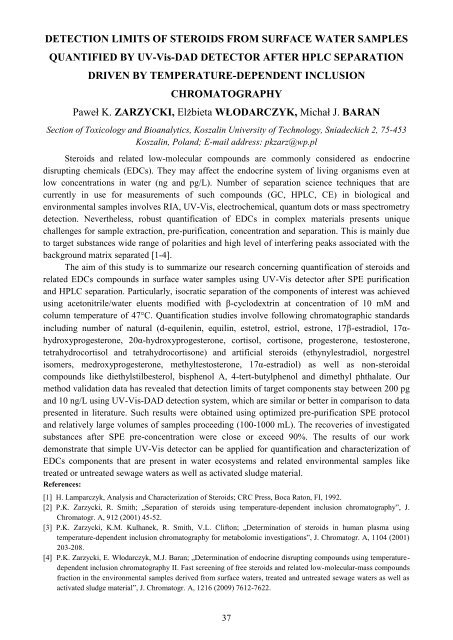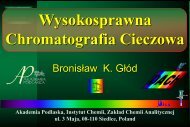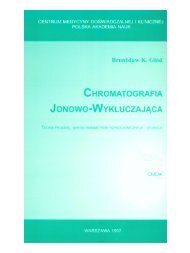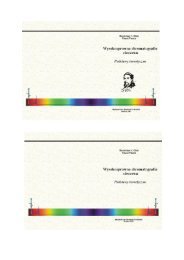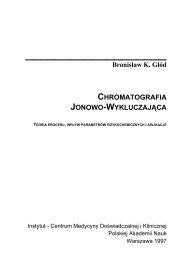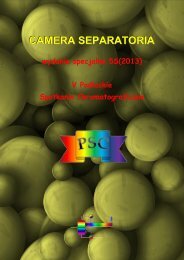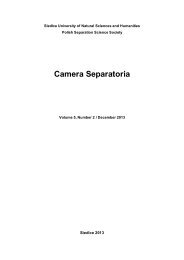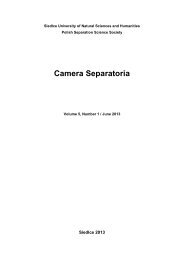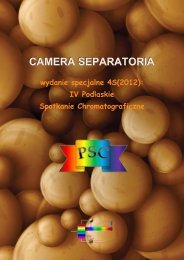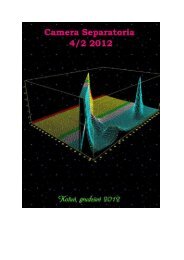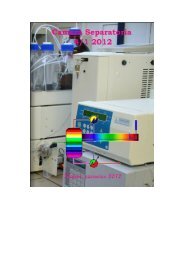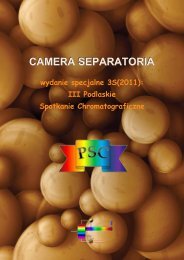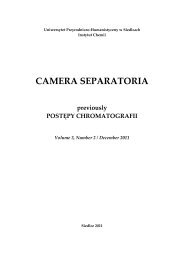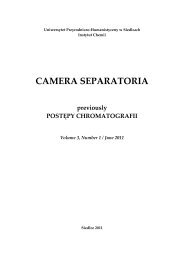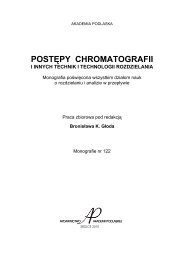CamSep 2 S
Create successful ePaper yourself
Turn your PDF publications into a flip-book with our unique Google optimized e-Paper software.
DETECTION LIMITS OF STEROIDS FROM SURFACE WATER SAMPLES<br />
QUANTIFIED BY UV-Vis-DAD DETECTOR AFTER HPLC SEPARATION<br />
DRIVEN BY TEMPERATURE-DEPENDENT INCLUSION<br />
CHROMATOGRAPHY<br />
Paweł K. ZARZYCKI, Elżbieta WŁODARCZYK, Michał J. BARAN<br />
Section of Toxicology and Bioanalytics, Koszalin University of Technology, Sniadeckich 2, 75-453<br />
Koszalin, Poland; E-mail address: pkzarz@wp.pl<br />
Steroids and related low-molecular compounds are commonly considered as endocrine<br />
disrupting chemicals (EDCs). They may affect the endocrine system of living organisms even at<br />
low concentrations in water (ng and pg/L). Number of separation science techniques that are<br />
currently in use for measurements of such compounds (GC, HPLC, CE) in biological and<br />
environmental samples involves RIA, UV-Vis, electrochemical, quantum dots or mass spectrometry<br />
detection. Nevertheless, robust quantification of EDCs in complex materials presents unique<br />
challenges for sample extraction, pre-purification, concentration and separation. This is mainly due<br />
to target substances wide range of polarities and high level of interfering peaks associated with the<br />
background matrix separated [1-4].<br />
The aim of this study is to summarize our research concerning quantification of steroids and<br />
related EDCs compounds in surface water samples using UV-Vis detector after SPE purification<br />
and HPLC separation. Particularly, isocratic separation of the components of interest was achieved<br />
using acetonitrile/water eluents modified with β-cyclodextrin at concentration of 10 mM and<br />
column temperature of 47°C. Quantification studies involve following chromatographic standards<br />
including number of natural (d-equilenin, equilin, estetrol, estriol, estrone, 17 -estradiol, 17αhydroxyprogesterone,<br />
20α-hydroxyprogesterone, cortisol, cortisone, progesterone, testosterone,<br />
tetrahydrocortisol and tetrahydrocortisone) and artificial steroids (ethynylestradiol, norgestrel<br />
isomers, medroxyprogesterone, methyltestosterone, 17α-estradiol) as well as non-steroidal<br />
compounds like diethylstilbesterol, bisphenol A, 4-tert-butylphenol and dimethyl phthalate. Our<br />
method validation data has revealed that detection limits of target components stay between 200 pg<br />
and 10 ng/L using UV-Vis-DAD detection system, which are similar or better in comparison to data<br />
presented in literature. Such results were obtained using optimized pre-purification SPE protocol<br />
and relatively large volumes of samples proceeding (100-1000 mL). The recoveries of investigated<br />
substances after SPE pre-concentration were close or exceed 90%. The results of our work<br />
demonstrate that simple UV-Vis detector can be applied for quantification and characterization of<br />
EDCs components that are present in water ecosystems and related environmental samples like<br />
treated or untreated sewage waters as well as activated sludge material.<br />
References:<br />
[1] H. Lamparczyk, Analysis and Characterization of Steroids; CRC Press, Boca Raton, FI, 1992.<br />
[2] P.K. Zarzycki, R. Smith; „Separation of steroids using temperature-dependent inclusion chromatography”, J.<br />
Chromatogr. A, 912 (2001) 45-52.<br />
[3] P.K. Zarzycki, K.M. Kulhanek, R. Smith, V.L. Clifton; „Determination of steroids in human plasma using<br />
temperature-dependent inclusion chromatography for metabolomic investigations”, J. Chromatogr. A, 1104 (2001)<br />
203-208.<br />
[4] P.K. Zarzycki, E. Włodarczyk, M.J. Baran; „Determination of endocrine disrupting compounds using temperaturedependent<br />
inclusion chromatography II. Fast screening of free steroids and related low-molecular-mass compounds<br />
fraction in the environmental samples derived from surface waters, treated and untreated sewage waters as well as<br />
activated sludge material”, J. Chromatogr. A, 1216 (2009) 7612-7622.<br />
37


